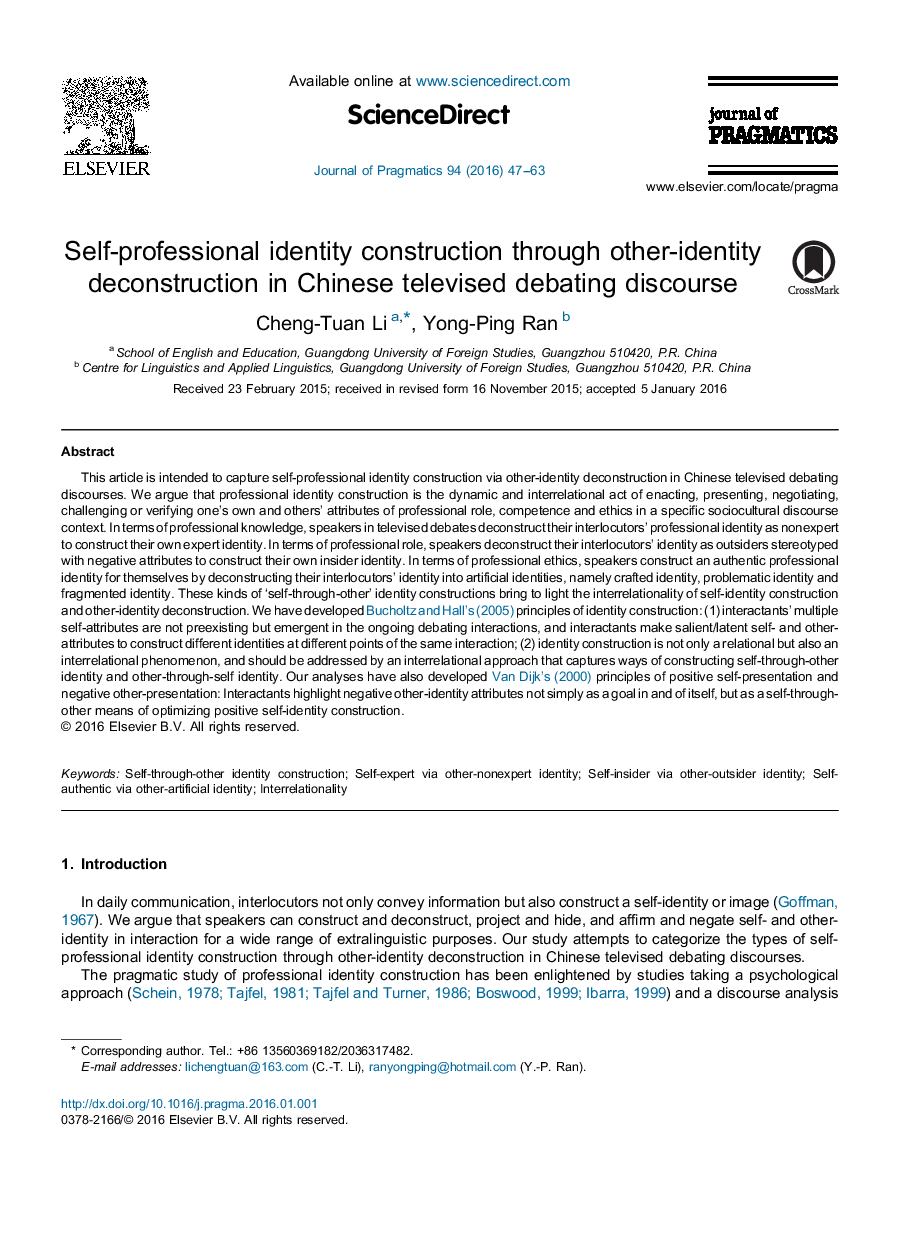| کد مقاله | کد نشریه | سال انتشار | مقاله انگلیسی | نسخه تمام متن |
|---|---|---|---|---|
| 7297982 | 1474706 | 2016 | 17 صفحه PDF | دانلود رایگان |
عنوان انگلیسی مقاله ISI
Self-professional identity construction through other-identity deconstruction in Chinese televised debating discourse
ترجمه فارسی عنوان
ساخت هویت حرفه ای خود را از طریق تفکیک دیگر هویت در بحث گفتگوی تلویزیونی در تلویزیون چینی
دانلود مقاله + سفارش ترجمه
دانلود مقاله ISI انگلیسی
رایگان برای ایرانیان
کلمات کلیدی
ساخت هویت خود را از طریق دیگر، خودمختار از طریق هویت دیگر غیرفعال، خودی خود را از طریق هویت بیگانه دیگر، از طریق هویت مصنوعی دیگر خود معتبر است همبستگی،
موضوعات مرتبط
علوم انسانی و اجتماعی
علوم انسانی و هنر
زبان و زبان شناسی
چکیده انگلیسی
This article is intended to capture self-professional identity construction via other-identity deconstruction in Chinese televised debating discourses. We argue that professional identity construction is the dynamic and interrelational act of enacting, presenting, negotiating, challenging or verifying one's own and others' attributes of professional role, competence and ethics in a specific sociocultural discourse context. In terms of professional knowledge, speakers in televised debates deconstruct their interlocutors' professional identity as nonexpert to construct their own expert identity. In terms of professional role, speakers deconstruct their interlocutors' identity as outsiders stereotyped with negative attributes to construct their own insider identity. In terms of professional ethics, speakers construct an authentic professional identity for themselves by deconstructing their interlocutors' identity into artificial identities, namely crafted identity, problematic identity and fragmented identity. These kinds of 'self-through-other' identity constructions bring to light the interrelationality of self-identity construction and other-identity deconstruction. We have developed Bucholtz and Hall's (2005) principles of identity construction: (1) interactants' multiple self-attributes are not preexisting but emergent in the ongoing debating interactions, and interactants make salient/latent self- and other-attributes to construct different identities at different points of the same interaction; (2) identity construction is not only a relational but also an interrelational phenomenon, and should be addressed by an interrelational approach that captures ways of constructing self-through-other identity and other-through-self identity. Our analyses have also developed Van Dijk's (2000) principles of positive self-presentation and negative other-presentation: Interactants highlight negative other-identity attributes not simply as a goal in and of itself, but as a self-through-other means of optimizing positive self-identity construction.
ناشر
Database: Elsevier - ScienceDirect (ساینس دایرکت)
Journal: Journal of Pragmatics - Volume 94, March 2016, Pages 47-63
Journal: Journal of Pragmatics - Volume 94, March 2016, Pages 47-63
نویسندگان
Cheng-Tuan Li, Yong-Ping Ran,
